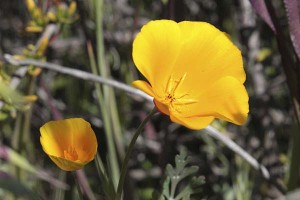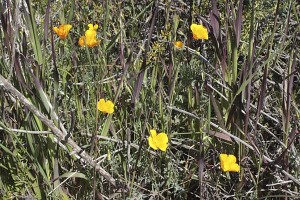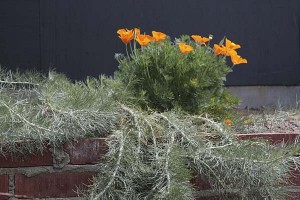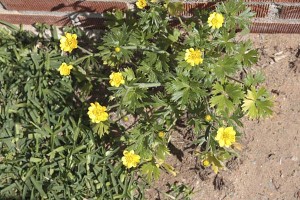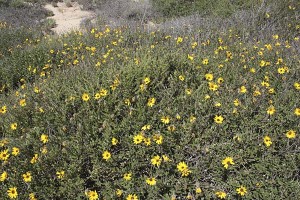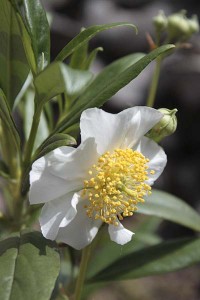This post may be mainly for the math nerds among you, but I think it could be interesting to any gardeners living in drought-prone parts of the world.
In my last post I mentioned that I’d used instructions in Olivier Filippi’s The Dry Gardening Handbook to figure out the drought stress index, or hydric deficit, for where I live in San Diego.
USDA zones are useful for dealing with minimum temperatures. For gardeners in the western U.S., Sunset zones provide more finesse, combining temperature with other climate conditions. The the drought stress numbers, however, are useful if you want to concentrate on understanding how many months a plant might be subjected to severe drying conditions due to lack of rainfall.
Filippi writes in his book that “everyone’s drought is different,” so be sure to consider factors other than this single number, things like total rainfall, humidity, the sun exposure a plant might get or the amount of wind your site experiences. The technique presented in The Dry Gardening Handbook derives from work of plant geographer Henri Gaussen.
Figuring out hydric deficit is pretty straightforward but will take a few minutes of your time. Either use a spreadsheet program like Excel or a sheet of paper. First, go to a site like World Climate where you can find your area’s monthly total rainfall and monthly average temperatures. On the spreadsheet or paper set up a column with the months of the year, January to December. Next fill in a column with the monthly average rainfall in millimeters, and another column with the average monthly temperature in degrees Celsius.
Now you have two options: Follow the instructions in the book, which isn’t that hard but requires making a graph with three different axes. Or use my simplified technique, which requires some calculations but no graphing. I’ll send you to the book for the somewhat more precise method, but here’s my easier method: In a fourth column, divide the rainfall number by the temperature and multiply by 2. That’s where the math comes in to play.
Here’s my result for San Diego:
| Month | Rainfall (mm) | Temperature (Celsius) | 2 x (Rainfall/Temperature) |
|---|---|---|---|
| Jan | 55.6 | 14.1 | 7.890 |
| Feb | 41.3 | 14.7 | 5.62 |
| Mar | 49.9 | 15.3 | 6.52 |
| Apr | 19.8 | 16.6 | 2.39 |
| May | 4.8 | 17.8 | 0.54 |
| Jun | 1.9 | 19.3 | 0.2 |
| Jul | 0.5 | 21.6 | 0.05 |
| Aug | 2.1 | 22.5 | 0.19 |
| Sep | 4.7 | 21.8 | 0.43 |
| Oct | 8.6 | 19.8 | 0.87 |
| Nov | 29.5 | 16.6 | 3.56 |
| Dec | 35.4 | 14.1 | 3.62 |
Count up the numbers in the fourth column that are less than 1, and that’s your approximate hydric deficit number. The higher the hydric deficit number, the more severe your drying conditions. For the San Diego Airport, the number is 6. (If you have a month where the average temperature is below freezing, for my oversimplified method just throw out that month and consider that there’s minimal hydric deficit.)
Now what do you with the number? For one thing, you can use it to compare you growing conditions with the drought resistance code for a plant in Filippi’s book. For example, the matilija (“tree”) poppy (Romneya coulteri) has a drought tolerance rating of 6–perfect for an unwatered garden in San Diego. By contrast, Ceanothus ‘Ray Hartman’ has a code of 4, and Hidcote Blue lavender (Lavandula angustifolia ‘Hidcote Blue’) has a code of 3. These other plants would probably survive without supplemental water, but to look their best the ceanothus might benefit from a couple months of occasional supplemental watering, and the lander maybe three. You can also use the number to compare the drying forces where you live other regions around you, or apply the number to better understand your climate in relation to that of a plant’s origin.
For fun, I added four other sites in San Diego County. You can see how the county offers a huge number of growing conditions, from dry coastal conditions, mountain meadows, backcountry chaparral, and full-on desert.
| City | Hydric deficit | |
|---|---|---|
| San Diego Airport | 6 | |
| La Mesa | 5-6 | |
| Cuyamaca | 1 | |
| Campo | 3 | |
| Borrego Springs | 7 |
And then a few other cities in California. You can see a general moistening the farther north you go, and a general drying as you head east towards the deserts.
| City | Hydric deficit | |
|---|---|---|
| Los Angeles | 6 | |
| San Bernardino | 4-5 | |
| Victorville | 6 | |
| Santa Barbara | 5 | |
| Monterrey | 4 | |
| San Jose | 4-5 | |
| Santa Cruz | 3 | |
| San Francisco | 4 | |
| Richmond | 4 | |
| Sacramento | 4-5 | |
| Fresno | 5 | |
| Yosemite National Park | 2 | |
| Eureka | 1 |
|
| Redding | 2 |
I’d never played with mapping in Google Maps, but thought this might be a fun first little project. I took the numbers above and applied them to a map. The results are pretty impressive for something that’s not hard to do. So far the blips are in California only, but I might work on the map some more to include other locations. Take a look…
View Hydric Deficit Map in a larger map


